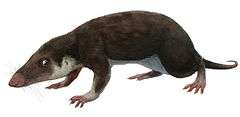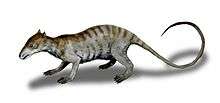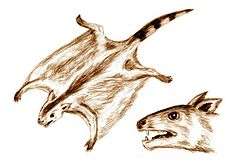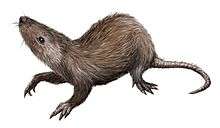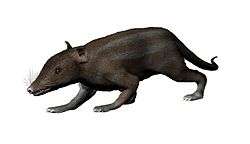Docodonta
Docodonta is an order of extinct mammaliaforms that lived during the Mesozoic, from the Middle Jurassic to Early Cretaceous. They are distinguished from other early mammaliaforms by their relatively complex molar teeth, from which the order gets its name. Until recently, Docodonta were represented primarily by teeth and jaws found across former Laurasia, (modern-day North America, Europe, and Asia). However, recent discoveries in China include some exceptionally well preserved, almost complete body fossils.[1][2]
| Docodonts | |
|---|---|
 | |
| Life restoration of Castorocauda | |
| Scientific classification | |
| Kingdom: | Animalia |
| Phylum: | Chordata |
| Clade: | Therapsida |
| Clade: | Cynodontia |
| Clade: | Mammaliaformes |
| Clade: | †Docodonta Kretzoi, 1946 |
| Genera | |
| |
Description
Docodontans are an early branch of the mammaliaform tree, but unlike other early mammals they developed a more complex tooth shape, allowing them to pierce and crush food. This tooth shape includes a series of tall cusps in two rows, and a basin between them called a pseudotalonid.[3] The 'pseudo-' refers to this structure's resemblance to the later true talonid basins on the tribosphenic teeth of crown Mammalia, which evolved convergently with those of the early docodontans.
Docodonts and other Mesozoic mammals were traditionally thought to have been primarily ground dwelling and insectivorous, but recent more complete fossils from China have shown this is not the case. Castorocauda[4] from the Middle Jurassic of China, and possibly Haldanodon[5][6] from the Upper Jurassic of Portugal, were specialised for a semi-aquatic lifestyle. Castorocauda had a flattened tail and recurved molars, which suggests possible fish or aquatic invertebrate diet.[4] It was thought possible that docodonts had tendencies towards semi-aquatic habits, given their presence in wetland environments,[7] although this could also be explained by the ease with which these environments preserve fossils compared with more terrestrial ones. Recent discoveries of other complete docodontans such as the specialised digging species Docofossor,[1] and specialised tree-dweller Agilodocodon[2] suggest Docodonta was more ecologically diverse than previously suspected. Docofossor shows many of the same physical traits as the modern day golden mole, such as wide, shortened digits in the hands for digging.
Taxonomy
Docodonts are not as closely related to the placentals and marsupials as the monotremes, and are not included in the crown-group mammals. The complexity of their molars and the fact that they possess the dentary-squamosal jaw joint, means that they were previously sometimes regarded as belonging to Mammalia. Modern authors usually limit the term "Mammalia" to the crown group, which excludes earlier mammaliaforms like the docodontans, but they are considered to be closer to Mammalia than many other early mammalian groups such as Morganucodonta, Kuehneotheriidae, Haramiyida and Sinoconodon.
One disputed docodont, Gondtherium, has been described from India, which was previously part of the Southern Hemisphere continent of Gondwana.[8] However this identification is not certain, and some authors have chosen to exclude it from their analyses of Docodonta. In recent analyses, Gondtherium falls outside the docodont family tree. There has also been a suggestion of erecting two sub-families (Simpsonodontidae and Tegotheridae) within Docodonta, but these groups are not found in any other analyses, and therefore not accepted by all mammal palaeontologists.
- Superfamily †Docodontoidea
- †Dsugarodon zuoi Pfretzschner et al. 2005 [Acuodulodon Hu, Meng & Clark 2007; Acuodulodon sunae Hu, Meng & Clark 2007]
- †Simpsonodon Kermack et al. 1987
- †S. splendens (Kühne 1969)
- †S. sibiricus Averianov et al. 2010
- Family †Docodontidae (Marsh 1887) Simpson 1929
- †Agilodocodon scansorius Meng et al. 2015[2]
- †Borealestes Waldman & Savage 1972
- †B. serendipitus Waldman & Savage 1972[9]
- †B. mussetti Sigogneau-Russell 2003
- †Castorocauda lutrasimilis Ji et al. 2006[4]
- †Cyrtlatherium canei Freeman 1979 sensu Sigogneau-Russell 2001 [disputed] [Simpsonodon oxfordensis Kermack et al. 1987]
- †Docodon Marsh 1881 [Dicrocynodon Marsh in Osborn, 1888; Diplocynodon Marsh 1880 non Pomel 1847; Ennacodon Marsh 1890; Enneodon Marsh 1887 non Prangner 1845]
- †D. apoxys Rougier et al. 2014
- †D. victor (Marsh 1880) [Dicrocynodon victor (Marsh 1880); Diplocynodon victor Marsh 1880]
- †D. striatus Marsh 1881 [disputed]
- †D. affinis (Marsh 1887) [Enneodon affinis Marsh 1887] [disputed]
- †D. crassus (Marsh 1887) [Enneodon crassus Marsh 1887; Ennacodon crassus (Marsh 1887)] [disputed]
- †D. superus Simpson 1929 [disputed]
- †Docofossor brachydactylus Luo et al. 2015[1]
- †Gondtherium dattai Prasad & Manhas 2007[8] [disputed]
- †Haldanodon exspectatus Kühne & Krusat 1972 sensu Sigoneau-Russell 2003[5]
- †Krusatodon kirtlingtonensis Sigogneau-Russell 2003
- †Peraiocynodon Simpson 1928
- †P. inexpectatus Simpson 1928 [possible synonym of Docodon, Butler 1939[10]]]
- †P. major Sigogneau-Russell 2003 [disputed]
- †Tashkumyrodon desideratus Martin & Averianov 2004
- Family †Tegotheriidae
- †Hutegotherium yaomingi Averianov et al. 2010
- †Sibirotherium rossicus Maschenko, Lopatin & Voronkevich 2002
- †Tegotherium gubini Tatarinov 1994
- Superfamily †Docodontoidea
See also
References
- Luo, Z., Meng, Q., Ji, Q., Liu, D., Zhang, Y., Neander, A. I. 2015 Evolutionary development in basal mammaliaformes as revealed by a docodontan. Science, 347, 6223, 760-764
- Meng, Q., Ji, Q., Zhang, Y., Liu, D., Grossnickle, D. M., and Luo, Z. 2015 An arboreal docodont from the Jurassic and mammaliaform ecological diversification. Science, 347, 6223, 760-764.
- Luo Z-X, and Martin T. 2007 Analysis of molar structure and phylogeny of docodont genera. Bulletin of the Carnegie Museum of Natural History 39: 27-47
- Ji, Q., Luo, Z., Yuan, C. and Tabrum, A. R. 2006 A swimming Mammaliaform from the Middle Jurassic and ecomorphological diversification of early mammals. Science, 311, 1123-1127.
- Kühne W. G. and Krusat, G. 1972. Legalisierung des Taxon Haldanodon (Mammalia, Docodonta). Neues Jahrbuch für Geologie Monatshefte 1972:300-302
- Krusat, G. 1991 Functional morphology of Haldanodon exspectatus (Mammalia, Docodonta) from the Upper Jurassic of Portugal. Fifth Symposium on Mesozoic Terrestrial Ecosystems and Biota.
- Paleontology and Geology of the Upper Jurassic Morrison Formation: Bulletin 36
- Prasad GVR, and Manhas BK. 2007. A new docodont mammal from the Jurassic Kota Formation of India. Palaeontologia electronica, 10.2: 1-11.
- Waldman, M and Savage, R.J.G 1972 The first Jurassic mammal from Scotland. Journal of the Geological Society of London 128:119-125
- Butler PM. 1939. The teeth of the Jurassic mammals. In Proceedings of the Zoological Society of London, 109:329-356). Oxford, UK: Blackwell Publishing Ltd.
